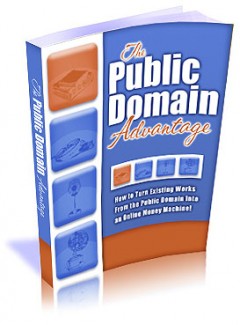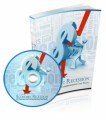 License Type: Master Resell Rights
License Type: Master Resell Rights  File Size: 409 KB
File Size: 409 KB File Type: ZIP
File Type: ZIP
 SKU: 28525
SKU: 28525  Shipping: Online Download
Shipping: Online Download
Sample Content Preview
Chapter 1:
Public Domain Exposed
The Public Domain Advantage
Public Domain Works - What Is It?
You may have heard of works that are in the public domain being used as new products by entrepreneurs today. This is a great way to start a business, or to improve the overall bottom line of an existing business.
Work that is in the public domain includes any work for which the copyright has expired, and not been renewed, any work that was published prior to 1923, works produced by the United States Government, and other specific Governments, Work that is donated to the public domain, or any other work that has no laws that restrict its use by the public.
The work itself may be in the form of a book, an article, a song, a film, a photograph, a painting, or even an invention. These works that are not covered by copyright laws, or are no longer covered by copyright laws, are free for the public to use as they see fit.
This does not mean that if a work is freely obtained it is in the public domain. In other words, if you saw it on a website, for free, that doesn’t mean that it is okay for you to use it. In fact, most things that are written down, in any form, are automatically copyrighted.
Public domain refers to work in which the copyright has run its course. According to the Copyright Office of the United States:
“The term of copyright for a particular work depends on several factors, including whether it has been published, and, if so, the date of first publication. As a general rule, for works created after January 1, 1978, copyright protection lasts for the life of the author plus an additional 70 years. For an anonymous work, a pseudonymous work, or a work made for hire, the copyright endures for a term of 95 years from the year of its first publication or a term of 120 years from the year of its creation, whichever expires first. For works first published prior to 1978, the term will vary depending on several factors.” (Source: http://www.copyright.gov) Public domain also refers to work that was meant for the public domain, such as work that is donated, as well as work that never had a copyright, which would be work that was created prior to 1923, or work that was not copyrightable material.
These materials are free for the public to use, in any manner that they choose. You can use bits and pieces of a public domain work, or the entire work itself. You can create new work from the bits and pieces, or sell an entire work – as you see fit.
Copyright or Copyleft?
You most likely know what a copyright is, but if you don’t, according to the United States Copyright Office, a copyright is a set of rights granted by the Government for a limited time to protect creative or artistic forms or works including literary works, movies, musical works, sound recordings, paintings, photographs, software, and industrial designs.
But what is Copyleft?
While Copyleft is NOT an actual legal term, such as copyright, it is often referred to as a reciprocal license. With a Copyleft, instead of a copyright, restrictions are usually imposed on a work stating that when the work is copied, modified, or used in any subsequent work, the author of that subsequent work must grant the same Copyleft rights to the public for the subsequent work. It’s kind of like passing the rights forward.
Copyleft is usually symbolized with a backward C in the copyright symbol. Copyleft is often used for open source computer software, documents, music, and art. Copyleft is essentially the opposite of a copyright.
Where a copyright basically says ‘no, you may not use my work,’ a Copyleft says ‘yes, please use my work, but you must allow others to use the work that you create from my work as well.’
The Public Domain Advantage
Just as there are copyright licenses on copyrighted work, there must be Copyleft licenses for Copyleft work as well. The most commonly accepted Copyleft license is the GNU General Public License, or as it is commonly known, the GPL which can be seen at:
- File Size:409 KB
- License: Master Resell Rights
- Category:Ebooks
- Tags:2010 Ebooks Master Resale Rights








